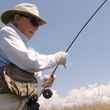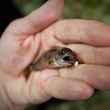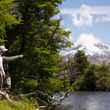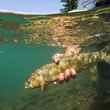Buddy Bishop, the man who owned the Racine, was about as un-Buddylike as it’s possible to be. You tend to think of Buddys as ruddy-cheeked back-slappers, the kind of guys who organize softball games at company picnics and spend the rest of the afternoon flipping burgers, tonging hot dogs into buns, and drinking foamy beer from plastic cups.
No one ever thought of Buddy Bishop that way. He was a proper gentleman, a man whose given name, Percival, suited him perfectly—although I never heard him addressed as such. He seemed like a Percival. Or at least he did when I knew him, during the last couple years of his life.
He was pushing 80 then, and his dress and demeanor were positively Edwardian: neatly trimmed silver mustache, ramrod-straight bearing, pants tucked into leather boots that laced all the way to the knee. He looked like a man who might have captained a regiment of Ghurkas in colonial India, or served as a British wing commander in World War I.
Buddy lived on Trout Lake, the crown jewel of Wisconsin’s North Country. His home was an Adirondacks-style log cottage, hewn of native tamarack in the late-1800s. This had been the heart of the pinery, but by the time Buddy’s grandfather bought the property a scant handful of that race of giants remained, their solitary eminence magnified by the fire-ravaged cutover that surrounded them.
I’d gotten to know Buddy through my part-time job with a local conservation land trust. Buddy had donated a pristine stretch of shoreline to the organization—he was appalled by what he termed “the disfiguring blight” of development—and as one of my duties was to familiarize myself with the properties under our protective umbrella, I called and arranged for him to show me around.
We met on a cloudy afternoon in early May, the ice just a few days gone from the lake, the trees barely beginning to bud. It didn’t lake long to walk the property. There was the beach of smooth gray cobbles ramping into the gelid water, a stand of gleaming white birches, a privacy fence where the estate abutted the road to the public boat landing. I took several photos for the file, jotted down some notes.
More Like This
Then Buddy remembered something he wanted to check on in the boathouse, another peak-roofed log structure that overlooked a teardrop-shaped cove. The cross-timbered doors were heavy, and after he’d opened the padlock Buddy beckoned for me to give him a hand throwing them back.
That’s when I first land eyes on the Racine. It was resting in a waist-high cradle, and even in that grainy light it took my breath away. A wood-and-canvas canoe will do that, rekindling every dormant romantic ember, recalling the abandoned dreams of youth. To a certain class of person—middle-aged white males, mostly, guys like me who’ve been influenced by Sigurd Olson et. al. to a degree that isn’t strictly healthy—it’s as evocative and unimprovable an object as human hands have ever fashioned.
The canoe was clearly very old. A filigree of hairline cracks webbed the green paint that covered the canvas; the ribs and planking had, with age and weather, developed the burnt umber patina of the Great Room in a Northwoods lodge. The design was old, too, with the peaked profile at bow and stern that brings to mind “Indian” canoes, and the dramatic taper that echoes an era when women squeezed themselves into corsets. It was a big, beamy craft—about a 17-footer, I guessed—and as I gazed, enraptured, I found myself thinking of Tait’s paintings of hunting the lake-studded wilderness from canoes much like this: buckskin-clad guide in the stern, dapper sport in the bow, whitetail buck stretched between them, the tines of its immense rack scraping the sky.
Studying the canoe more critically, I could see that its flat bottom and brass-banded keel bespoked the strength and stability necessary to handle big water like Trout Lake. And on the mahogany cowling, an oval decal bore the maker’s name and address: Racine Boat Company, Racine, Wisconsin, USA.
This was the final proof of the canoe’s antiquity. Although I’m by no means an authority on the subject, I knew that it had been a long, long time since the Racine Boat Company had been a going concern. The idea of canoes like this being produced in quantity is difficult to reconcile with our image of the boat builder as a solitary, infinitely patient craftsman; it tests the imagination, in the 21st century, to conceive of entire factories staffed with men possessing such abstruse, almost mystical skills as steaming and bending ribs, fairing hulls, and stretching and filling canvas. But it was possible, once—the evidence lay right in front of me—and as I stared at the Racine something else became obvious: the great pride that those forgotten artisans took in their work.
Its age notwithstanding, the canoe had been lovingly cared for. “She’s still in good shape,” Buddy volunteered, as if he’d been reading my mind. “I just had the seats re-caned, and in another year or two she’s due to have the canvas replaced—although I have to confess that I’ve lost track of anyone who does that sort of thing.”
“Mike Lynch down on Lake Tomahawk might,” I said, reverently running my fingertips along the gunwale, the dents and nicks there forming the braille of stories I’d never know. “Give him a call. They just don’t make canoes like this anymore.”
“No, they don’t,” he agreed. “I’ve had her since I was a boy, and she’s been one of the joys of my life. I traveled a lot in my time, but no matter where I was, I was waiting for the moment I’d get back to Trout Lake and put the canoe in the water. Paddling to Cathedral Point was my favorite thing in the world. I’d pack a lunch and make a day of it.”
Buddy stepped around the bow, reached up, brushed away some cobwebs, and removed a fishing rod that was balanced on a pair of screw-hooks. The rod was equipped with an old level-wind casting reel filled with black braided line; a spinner with a fluted blade and a long single hook dangled from the tip.
“I was never much of a fisherman,” Buddy said, gripping the rod in his right hand with his thumb on the reel’s spool, “but sometimes Mother would say she wanted a walleye for dinner. So on the way home I’d troll a spinner-and-minnow. It was no trick to catch walleyes then. Big ones: five, six, seven pounds. I tangled with a few muskies, too. Would you believe me if I told you I once had a muskie jump right into the canoe, and that it landed with its head and tail straddling the gunwales?”
“Yes, I would.”
“It’s true. I’ll never forget that sight for as long as I live. Then it gave a mighty flop, crashed back into the water, and broke the line. That was right in front of the point. You’re familiar with Cathedral Point, I presume?”
“Oh, sure,” I replied. “Gorgeous spot. I’m told it’s the last large stand of virgin white pines south of the Keweenaw.”
“You’re very well-informed,” he nodded. “What you may not know is that it was sacred to the Ojibwe long before the Jesuits appropriated it. They believed they heard the voices of the Old Ones there, murmuring in the wind. Whenever I paddled to Cathedral Point I’d build a little fire, boil up a pot of tea, and listen for the voices myself. There were times I fancied I heard them.”
Buddy paused then, a trace of a smile on his lips and a far-away look in his eyes.
“Of course,” he resumed, “it’s been years since I was able to paddle that far. Now I stick pretty close to the cottage.”
With that, his business in the boathouse done, Buddy returned the rod to its holder, strode out, and directed me to help him swing the doors shut. Our business was done, too, and after shaking hands and exchanging the usual pleasantries, I rattled back across the washboard rods to the bungalow I was renting on the Manitowish River. It had occurred to me to mention that I’d be interested if he ever decided to sell his canoe, but I thought better of it and held my tongue. It wasn’t the kind of question a gentleman asked.
A year went by before I saw Buddy again, and during that time his health had visibly deteriorated. He’d grown gaunt and stooped; his skin had the brittle translucence of waxed paper. I tried to affect a chipper tone, but it was clear that he was living on borrowed time.
“Have you gotten out in the canoe?” I asked.
“No,” he sighed, giving his head a bitter little shake. “Not once. I’d hoped to have new canvas on her by now, but what would be the point? Besides, those infernal jet skis have taken over the lake. I doubt I’ll ever paddle her again.”
And he never did. Somehow, though, he summoned the strength to satisfy his last unfulfilled desire and take a trip around the world. It took two months, and by all accounts Buddy relished every minute. Then, his affairs in order, he died. We should all go out so decorously.
Buddy had left a small sum to the land trust, and a few weeks after his passing I phoned his attorney to check on the status of the bequest.
“The money’s in the pipeline,” the attorney assured me. “But if you don’t get a check by the end of the month, give me a shout and I’ll try to shake it loose.”
“Just out of curiosity,” I asked, “you don’t happen to know what became of that old canoe of Buddy’s, do you?”
“The canoe? Well, I can’t say for sure, but as far as I know it’s still there. As a matter of fact, the executor of the estate, a cousin of Buddy’s named Sid Layton, is at the house right now sorting through the personal property. If you’re interested in the canoe you should give him a call. He’s a hell of a nice guy.”
Sid Layton proved to be exactly as advertised. We reminisced about Buddy, and he confirmed that the impressions I’d formed of him were correct.
“He was one of a kind,” Sid mused. “He acted as if the world hadn’t changed in a hundred years. Buddy didn’t let his hair down often, but when he did it was Katie-bar-the-door. He’d play the piano, sing Tin Pan Alley stuff, and tell stories that had everyone in stitches. It may be hard for you to believe, but Buddy could be the life of the party.”
He was right: It was hard to feature the Buddy Bishop I’d known making like Cole Porter. But I was glad to learn that this intensely private, self-contained man had a fun-loving side, too. I only wished I’d had the opportunity to see it.
When it finally came time to talk turkey, Sid shrugged and said, “Look, I really have no idea what the canoe is worth. But I think it’s important that it goes to someone who knew Buddy and knew how much it meant to him. I think Buddy would want that, too.”
I took delivery of the Racine on a quintessential Northwoods summer day: cool, leaf-tossing breeze; sky so blue it seemed freshly scrubbed; a few puffy, cotton-candy clouds. I felt a solemn elation as I secured her onto the trailer. I was thrilled to have her, but my joy was tempered by a nagging sense that the canoe had belonged to Buddy in a way that it could belong to no one else, that she would never give herself to me as completely as she had to him.
Driving home with the Racine in tow, I flashed on the final scene in The Graduate, the one in which Dustin Hoffman, having just snatched Katharine Ross from her husband-to-be, stares vacantly out the window of the bus. He’s invested his entire being into winning the girl of his dreams, but now that he has her he doesn’t have the foggiest notion of what to do next. He was so focused on the task he’d set for himself that he couldn’t see beyond the moment, and with his future staring him in the face he’s utterly terrified.
I wondered if I’d put myself in the same boat. I imagined fly-fishing for smallmouth from the Racine, stealthily paddling within casting range of the rocky, reed-stippled points the big bass favor; I dreamed of throwing in a couple sacks of decoys, paddling through the misty, pre-dawn chill, and setting up for ducks near the wild rice beds in the Manitowish’s languorous widenings.
Beyond that, though, I had no real plan. There were the maintenance concerns to deal with—concerns that make wood-and-canvas canoes demanding mistresses—and it was obvious that no matter how much attention I lavished on the Racine I could never match Buddy’s standard. There was simply a bigger place in his life for her than there could possibly be in mine. There was more room at his dock.
This gnawed at me for a while, but then it began to seem curiously liberating. It made me realize that I could only do what I could do, and that simply keeping the Racine afloat and reasonably ship-shape was a far nobler fate than has befallen 99 percent of the wood-and-canvas canoes every built.
I haven’t done much fly fishing from her—although I’ve been known to troll a spinner-and-minnow—and the dream of paddling up the Manitowish to hunt ducks remains a dream. But at least once every summer I take the Racine out on Trout Lake. I pack a lunch, put in at the landing near Buddy’s old property, and make a day of it. Paddling the Racine is like feeling silk move against a woman’s skin. The water sighs beneath her; she moves with the unhurried grace of royalty. And I swear that she doesn’t respond to the stroke of a paddle so much as she anticipates it, joining in the rhythm like, yes, a lover.
It’s easy to understand why, from those board rooms overlooking the concrete and steel of distant cities, Buddy Bishop longed to come back to her.
And sometimes, the Racine fetched up on shore beneath those ancient pines, the wind in their branches whispering words the Ojibwe heard plainly but the rest of us have neither the ears nor the language for, I wonder if he ever really left.































Comments